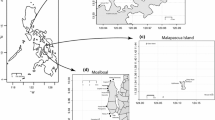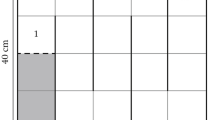Abstract
The predatory behavior of 74 Pacific electric rays (Torpedo californica), studied between August and December during 1988 through 1991 in situ off the Palos Verdes Peninsula, southern California, consisted of two feeding modes: an ambush from the substratum during the day and a more vigorous attack from the water column at night. Predatory motor patterns and electric organ discharges (EODs) were recorded on the video and audio channels of a housed camcorder. Predatory motor patterns included four phases: (1) jump (simultaneous with EOD initiation), (2) pectoral-fin cupping, (3) orientation to prey, and (4) ingestion. The initial electrical activity of the rays was a train of 46 to 414 5-ms monophasic EODs that lasted 0.45 to 7.06 s; the maximum number of EODs produced during an attack was >1200. Maximum output, measured on only one ray, was 45 V. Fifty-five rays were presented one of four types of prey stimuli: live fish (LF), freshly-speared fish (FSF), frozen fish (FF), or a simulated bioelectric field (SBF). The percent frequency of attacks for the LF, FSF, and FF treatments ranged from 70 to >90%, but was <30% for the SBF. The interval between prey presentation and attack was ≃30 s for the LF, FSF, and FF and over five times longer for the SBF; intervals averaged <4 s for the three rays tested at night. Attacks by rays on energized electrodes provide the first evidence that electric rays use electroreceptors to detect their prey. However, the lack of clear differences among the four prey treatments in five characteristics of the initial pulse train suggests that a suite of sensory stimuli cooperate in triggering an attack and regulating the electrical output during the attack.
Similar content being viewed by others
References
Auger D, Fessard A (1928) Quelques données relatives a la décharge électrique des torpilles. Bull Stn biol Arcachon 25:189–207
Belbenoit P (1970) Comportement alimentaire et décharge électrique associée chez Torpedo marmorata (Selachii, Pisces). Z vergl Physiol 67:205–216
Belbenoit P (1979) Electric organ discharge of Torpedo (Pisces); basic pattern and ontogenetic changes. J Physiol, Paris 75:435–441
Belbenoit P (1981) Sensory control of predatory and defensive behaviours in Torpedo marmorata (Pisces). In: Szabó T, Czéh G (eds) Sensory physiology of aquatic lower vertebrates. Pergamon Press, Akadémiai Kiadó, Budapest, p. 235–254
Belbenoit P (1986) Fine analysis of predatory and defensive motor events in Torpedo marmorata (Pisces). J exp Biol 121:197–226
Belbenoit P, Bauer R (1972) Video recordings of prey capture behaviour and associated electric organ discharge of Torpedo marmorata (Chondrichthyes). Mar Biol 17:93–99
Belbenoit P, Moller P (1971) Relations entre la taille de la torpille (Torpedo marmorata) et les charactéristiques de sa décharge alimentaire. J Physiol Paris 62 (Suppl 1):121–122
Bennett MVL (1971) Electric organs. In: Hoar WS, Randall DJ (eds) Fish physiology. Academic Press, New York, p. 347–491
Bennett MVL, Wurzel M, Grundfest H (1961) The electrophysiology of electric organs of marine electric fishes. I. Properties of electroplaques of Torpedo nobiliana. J gen Physiol 44:757–804
Bray RN, Hixon MA (1978) Night shocker: predatory behavior of the Pacific electric ray (Torpedo californica). Science, NY 200: 333–334
Coates CW, Cox RT (1942) Observations on the electric discharge of Torpedo occidentalis. Zoologica, NY 27:25–28
Crowley PH (1992) Resampling methods for computation-intensive data analysis in ecology and evolution. A Rev Ecol Syst 23: 405–447
Kalmijn AJ (1972) Bioelectric fields in sea water and the function of the ampullae of Lorenzini in elasmobranch fish. University of California, Scripps Institution of Oceanography. La Jolla, California (SIO Ref 72-83)
Kalmijn AJ (1978) Electric and magnetic sensory world of sharks, skates, and rays. In: Hodgson ES, Mathewson RF (eds) Sensory biology of sharks, skates, and rays. US Government Printing Office, Washington, DC, p. 507–528
Mellinger J, Belbenoit P, Ravaille M, Szabo T (1978) Electric organ development in Torpedo marmorata, Chondrichthyes. Devl Biol 67:167–188
Michaelson DM, Sternberg D, Fishelson L (1979) Observations on feeding, growth and electric discharge of newborn Torpedo ocellata (Chondrichthyes, Batoidei). J Fish Biol 15:159–163
Pfeiffer W (1961) Zur Biologie des Zitterrochens (Torpedo marmorata Risso). Pubbl Staz zool Napoli (I: Mar Ecol) 32:167–171
Radil-Weiss T, Kovačevič N (1970) Influence of low temperature on the discharge mechanism of the electric fish Torpedo marmorata and T. ocellata. Mar Biol 5:18–21
Sokal RR, Rohlf FJ (1981) Biometry The principles and practice of statistics in biological research. 2nd ed. W. H. Freeman & Co., New York
Zimmermann H, Whittaker VP (1974) Effect of electrical stimulation on the yield and composition of synaptic vesicles from the cholinergic synapses of the electric organ of Torpedo: a combined biochemical, electrophysiological and morphological study. J Neurochem 22:435–450
Author information
Authors and Affiliations
Additional information
Communicated by M. Strathmann, Friday Harbor
Rights and permissions
About this article
Cite this article
Lowe, C.G., Bray, R.N. & Nelson, D.R. Feeding and associated electrical behavior of the Pacific electric ray Torpedo californica in the field. Mar. Biol. 120, 161–169 (1994). https://doi.org/10.1007/BF00381951
Received:
Accepted:
Issue Date:
DOI: https://doi.org/10.1007/BF00381951




